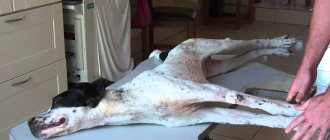Diseases of the cardiovascular system are a problem not only for people, but also for our little brothers. Among heart diseases, heart failure in dogs occupies a leading position.
This is a fairly serious pathology that causes a deterioration in the quality of life and a shortening of life in animals. At the same time, if your pet is diagnosed with heart problems, then with proper treatment and following all veterinarian recommendations, he can live a long life.
What is congestive heart failure?
Congestive heart failure (CHF) is a term that refers to the inability of the heart to adequately pump blood throughout the body. There are many causes of heart failure syndrome in dogs. The two most common causes are mitral valve regurgitation (due to endocardiosis) or relative mitral regurgitation (the valve between the left atrium and left ventricle) due to dilated cardiomyopathy (DCM). For more information, please see our website materials:
- "Heart disease - Dilated cardiomyopathy"
- "Heart disease Endocardiosis - Mitral valve disease"
Clinical signs vary depending on whether the dog has left or right chamber heart failure. The most common symptoms of congestive heart failure are decreased stamina, coughing, or difficulty breathing.
What is the difference in symptoms between different types of cardiac decompensation in dogs?
Right-sided congestive heart failure (RS-CHF) causes poor venous return of blood to the heart. In other words, when the heart contracts or “pumps” poorly, namely, the pumping function of the right ventricle, which normally should push blood through the lungs for adequate oxygenation, is impaired, some of the blood can be thrown back into the right atrium with absolute or relative insufficiency of the tricuspid valve (the valve between right atrium and right ventricle). This blood returns to the systemic circulation (the main circulation in the dog's body) and, therefore, the heart becomes "overloaded in volume." With this problem, eccentric hypertrophy of the right chambers of the heart occurs. As decompensation develops, fluid begins to accumulate in the abdominal cavity, disrupting the functions of internal organs. The abdominal cavity may fill with fluid, a condition called ascites. Fluid may also leak from veins in the extremities, causing tissue swelling known as peripheral edema. In animals, cardiogenic peripheral edema without ascites is rare.
In left-sided congestive heart failure (LS-CHF), when the heart contracts or pumps blood inadequately, instead of the left ventricle pushing blood into the systemic circulation, some blood flows through the mitral valve back into the left atrium and then back to the lungs. The fluid then penetrates into the lung tissue, leading to pulmonary edema. This pathogenetic mechanism causes coughing and difficulty breathing. Cough due to heart pathology in dogs can also be of a mechanical nature: compression of the left bronchus by a dilated left atrium. Left-sided congestive heart failure (LS-CHF) is the most common form of congestive cardiac decompensation in dogs. The classic signs of heart failure are coughing and fluid accumulation in the lung tissue (pulmonary edema) caused by left-sided decompensation, or fluid accumulation in the chest cavity - most often caused by right-sided decompensation in dogs.
Is cardiac decompensation associated with heart valve disease?
The cause of CHF in dogs of dwarf and small breeds is most often insufficiency of the atrioventricular valves. It is estimated that 80% of cases of CHF in dogs are caused by mitral valve endocardiosis. However, there are many other reasons. Disease of the heart muscle (cardiomyopathy), rhythm disturbances, and narrowing of certain major blood vessels (the aorta and pulmonary artery) can also cause CHF. Initially, mitral valve endocardiosis leads to left-sided CHF. If left untreated, heart failure can progress to involve both sides of the heart (total or biventricular heart failure).
What clinical signs should owners of pets with known heart problems expect?
“...a persistent cough accompanied by difficulty breathing and poor exercise tolerance.” The most common clinical sign of congestive heart failure (CHF) in dogs is a persistent cough accompanied by difficulty breathing. This type of cough is usually not observed in cats. This sign is mainly associated with pulmonary edema or fluid accumulation in the lung parenchyma. An enlarged heart will also put pressure on the trachea, causing mechanical irritation that may cause coughing. Many dogs with CHF get tired quickly, have decreased stamina, and do not engage in play or walking as much as they used to. Cough while resting or sleeping, excessive shortness of breath, persistent loss of appetite, enlargement of the abdomen and pale or bluish gums are also signs associated with heart failure. The dog may develop generalized weight loss and wasting due to loss of muscle tissue due to the effects of CHF on many other body systems. If any of these signs develop in your pet with a heart murmur, notify your veterinarian immediately.
Proper care at home
The task of experienced veterinarians is to prevent irreversible consequences in the dog’s health, normalize its condition and eliminate the clinical manifestations of heart failure. However, in addition to drug treatment, your pet requires proper care at home.
If your pet is diagnosed with acute or chronic heart failure, you will need to follow a set of measures:
- dose physical activity,
- provide emotional peace
- eliminate stressful situations,
- change your pet's diet by adding foods high in thiamine, magnesium, selenium and vitamin E.
Remember: the sooner you seek professional veterinary help, the greater the chance of your pet returning to a healthy life!
How is CHF diagnosed?
As with any heart problem, diagnosis involves several tests:
- Auscultating, or listening to the heart with a stethoscope, is the first step in diagnosing heart disease. Heart murmurs are detected by auscultation; The location and intensity of the noise helps determine its significance. The rhythm of the heart is assessed and, if there is a problem, the veterinarian may simultaneously palpate the femoral artery pulse to determine its strength, amplitude, filling, tension and rhythm. Finally, lung health is also assessed, looking for signs of changes associated with heart failure in older dogs.
- Chest X-rays are used to evaluate the size and shape of the heart and detect changes in the lungs, such as the presence of fluid in the lung tissue or pleural space. X-rays can also identify problems with the respiratory tract in toy and small breed dogs.
- Blood and urine tests are done to determine any other abnormalities in the body. Liver and kidney function is often impaired in patients with heart disease.
- An electrocardiogram (ECG) measures the electrical activity of the heart and can accurately determine heart rate and heart rhythm. Any abnormal rhythms (arrhythmias and heart blocks) can be detected and assessed in conjunction with existing cardiac symptoms and syndromes.
- An ultrasound test (echocardiogram) uses ultrasound waves to evaluate the condition of the heart. The size and thickness of each chamber of the heart can be assessed and the efficiency of heart contraction (contractility) can be assessed using this method. Measurements may be taken to assess the efficiency of the heart. It is possible to evaluate systolic function, diastolic function, cardiac output, the presence of high pulmonary hypertension, cardiac remodeling, and hemodynamic status using the echocardiographic method.
First aid
If your pet has already been diagnosed with heart failure, then your veterinarian should advise you and tell you how you can help your dog during an exacerbation.
Since there are so many predisposing pathologies, there is no single mechanism of action, each case is unique.
If your pet does not have a diagnosis, but you suspect heart problems, then you need to see a veterinarian as soon as possible. The work of the heart is a complex system, and without diagnosis and proper knowledge, you can harm your dog on your own.
A veterinarian cannot effectively treat a dog without a comprehensive diagnosis?
“An accurate diagnosis gives us much more information and we can determine the type, combination and extent of treatment needed, as well as the effective dosage of medications.”
An accurate diagnosis gives us much more information about the type and extent of treatment needed. Today, there is a wide variety of cardiac medications that can be used to treat congestive heart failure in dogs and other animals, and treatment regimens must be tailored to each patient individually. Without these tests, your veterinarian will not be able to determine the best treatment for your pet and may inadvertently cause more harm than good. With proper treatment, many dogs can live normal lives for many months or years.
Treatment
The drugs themselves are prescribed exclusively by a veterinarian after diagnosis. Most likely, you will have to continue treatment at home, but with specific prescriptions from the doctor.
As a rule, at the first and second stages the following drugs are prescribed:
- angiotensin converting enzyme inhibitors (ACEIs) - to relieve vasospasm and prevent fluid retention in the body (to prevent edema);
- diuretics.
And already at the third and fourth stages there are much more medications:
- ACEI;
- diuretics;
- calcium channel sensitizers (for example, vetmedin) the mechanism of action is that these drugs increase the force of heart contractions without increasing the heart rate;
- cardiac glycosides;
- PDE inhibitors;
- metabolic drugs (mineral supplements).
It is very important that the medications are prescribed and the dosage calculated by a specialist.
Most of these drugs have strict contraindications and serious side effects in case of overdose.
Clinical symptoms in dogs with cardiac pathology
There is no single or group of pathognomonic symptoms of circulatory failure (heart failure in dogs). Clinical cases of damage to one side of the heart in dogs are relatively rare, therefore, for convenience, it is customary to use the main clinical symptoms of heart failure in dogs in relation to the side of the heart that caused its occurrence.
Clinical symptoms of left-sided heart failure in dogs
The most common symptoms of left-sided heart failure in dogs
refers to “cardiac cough”, which is a consequence of pulmonary congestion or pulmonary edema. At first, a mild cough may appear only after physical activity. As the disease progresses, it becomes frequent, dry and constant. A cough caused only by hyperemia is dry, chronic, without sputum. With pulmonary edema, sputum may appear, which the dog swallows. Depending on the duration of the cough, the veterinarian can estimate approximately how long the dog has been suffering from circulatory failure.
Summary: Symptoms and signs of heart failure in a dog - decreased tolerance to physical exercise, congestion in the pulmonary circulation - shortness of breath, tachypnea, dyspnea, possible cyanosis, congestion in the systemic circulation - overflow of the jugular veins with blood, positive venous pulse, ascites, hepatomegaly, peripheral edema. Convulsions in animal cardiology are extremely rare, and fainting (syncope) is very common. Symptoms of this pathology can also be presented - fainting, cough, cachexia, arrhythmia, lethargy, hyporexia.
Another symptom of left-sided circulatory failure
- shortness of breath. As the disease progresses, characteristic difficulty breathing may appear. In this case, the dog stands with its paws spread wide, its head lowered, and its neck straightened. Perhaps in this way she is trying to ensure free passage of air. Fatigue in active dogs can also be a sign of left-sided deficiency.
Prevention measures
The following preventative measures will significantly reduce the risk:
- Balanced feeding, consistent with age, breed, physiological characteristics. The dog should not gain weight, but at the same time, his body should receive all the necessary nutrients, micro- and macroelements.
- It is necessary to normalize physical activity at an early age. The dog is growing quickly, but his heart is growing much slower in size. No need to overload it.
Clinical symptoms of right-sided heart failure in dogs
In dogs suffering from right-sided circulatory failure,
The most common clinical manifestation of the disease is ascites. Another symptom of right-sided heart failure in dogs is a violation of the systemic circulation - an enlarged liver, which is easy to detect when palpating it. Another symptom of the disease is swelling of the limbs and subcutaneous tissue. The symptom of overload of the systemic circulation can most clearly be detected in the external jugular vein, where hyperemia is expressed in its increased pulsation.
Common clinical signs of heart failure in older dogs
It is believed that the most constant general symptom of circulatory insufficiency is a rapid heartbeat, which is a kind of compensatory mechanism that is activated in the case of circulatory insufficiency in general, without being a direct consequence of the disease itself. In cases of bilateral failure, the heart rate increases to compensate for the decreased blood flow.
Development of the disease and symptoms of heart failure in dogs
The severity of any symptom depends on the stage of development of the disease
at the time of examination by a veterinarian. In the early stages of the disease, dogs usually show no signs of illness, even during intense exercise. The fact is that the damage has not yet reached the degree where the inclusion of a compensatory mechanism is required. Later, perhaps after several years, circulatory failure will entail the activation of mechanisms, the effect of which can only be detected clinically using radiograph readings. But even at this stage, most dogs show no signs of the disease after mild exercise. But if the load increases or the dog is very excited, the first signs of hyperemia appear. As the disease progresses, they begin to appear even with a small load and, finally, with its complete absence. Determining the stage of the disease is no less important than diagnosing the deficiency itself. The success of treatment largely depends on how well the patient’s disease course is studied.
Case history of heart failure in aging dogs
In addition to the usual information (age, gender, weight, nutrition, vaccinations), there are indications that must certainly be included in the history of each case of suspected circulatory failure. These include:
- condition after cough;
- water consumption mode;
- urination pattern;
- degree of physical activity;
- previous heart disease;
- weight change over the past six months.
Signs of the disease at different stages
Attentive dog owners may suspect the presence of the disease even in childhood. If at least 1 sign appears at a young age, then most likely we are talking about a congenital disease. In this case, the animal’s condition needs to be monitored for the puppy’s normal life and if there is the slightest change, consult a doctor. These may be sudden fainting, lethargy, constant sleep, refusal to eat, shortness of breath, blue mucous membranes. As an adult, the animal quickly gains weight, drinks a lot of water often, and coughs heavily. An elderly dog has swelling in the chest and paws, there is no appetite, the animal constantly wants to sleep and does not want to move.
Stages of heart failure in dogs
Heart diseases can be compensated for a long time by the body of sick animals. Therefore, it is important to classify the stages of cardiovascular pathology. It is also important to answer the question: “Is the symptom found cardiogenic or non-cardiogenic?”
The following stages of development of cardiac pathology are distinguished (Chief or ACVIM classification - American College of Internal Veterinary Medicine):
- Stage A
- predisposition to cardiovascular disease, that is, these are clinically healthy middle-aged and elderly small breed dogs (for example, dachshund or Pekingese). That is, these are the animals that can get sick. - Stage B1
is the appearance of cardiac pathology, that is, the presence of deformation of the mitral valve leaflets, there may be noise, but the disease is fully compensated, there is no hemodynamic disturbance, no myocardial remodeling, no symptoms of heart failure. There is no treatment at this stage. Only monitoring of general condition and echocardiographic parameters over time. - Stage B2
- corresponds to the stage of development of cardiac pathology, when there is a cardiac disease, for example endocardiosis, pronounced hemodynamic disturbances have already begun, the processes of heart remodeling have begun, but the dog does not yet have symptoms of CHF. At this stage, dilatation of the left atrium and/or eccentric hypertrophy of the left ventricle is detected. According to the EPIC study, at this stage of the disease it is already necessary to prescribe preventive treatment with pimobendan. Initial pulmonary edema in a chronic course may be asymptomatic for some time. If congestion is detected radiographically or echocardiographically in an asymptomatic patient, then it is necessary for such a patient to be prescribed medications from the group of loop diuretics (for example, furosemide). - Stage C
- symptomatic CHF, that is, there is cardiac pathology, there are serious hemodynamic abnormalities and cardiac remodeling, there are symptoms and signs of cardiac decompensation in dogs. Treatment is required. In addition to pimobendan, angiotensin-converting enzyme inhibitors, loop diuretics, and symptomatic agents are used. Therapy at this stage gives a good positive effect. At this stage, the disease debuts in the form of pulmonary edema. - Stage D
- symptomatic CHF refractory to standard therapy. At this stage, as a rule, sitolic dysfunction of the left ventricular myocardium, decreased cardiac output, and a restrictive type of diastolic dysfunction are detected; symptoms of ascites, hydrothorax, edema, and exhaustion often occur. At this stage, the likelihood of pulmonary edema decreases, but the risk of ascites increases. Convulsions in CHF are not a typical symptom, and fainting is often observed. Standard treatment does not help, frequent laparocentesis and thoracentesis are required, maximum doses of drugs from the group of loop diuretics are used, maximum doses of pimobendan (allowed up to 0.5 mg/kg body weight 3 times a day, long-term), maximum doses of veroshpiron (2-4 mg /kg 2-3 times a day, long-term), maximum doses of ACE inhibitors (ENAP, enalapril, ramipril, benazepril), hypothiazide and diacarb (3 and 4 diuretics) and various symptomatic drugs. If tolerance to diuretics occurs, correct hyponatremia and hypoalbuminemia. Additional salting of the feed and intravenous infusion of albumin may be required. Correction of high pulmonary hypertension with sildenafil, with the additional use of nitric oxide donors (L-arginine) and improvement of blood rheological properties (clopidogrel and acetylsalicylic acid). In acute decompensated heart failure, intravenous infusion of drugs from the group of ionotropes (pimobendan or dobutamine or levosimendan) may be required. At this stage of the disease, improving the pet’s quality of life is important; prolonging life takes a back seat. At this stage of heart disease, euthanasia may be recommended.
Heart failure in dogs: treatment
Treatment of heart failure in dogs
mostly nonspecific, practically independent of the cause of the pathology that caused it. For cardiac pathology in dogs without signs of cardiac failure, treatment is not required. The state of the body, the manifestation of symptoms, and the functional class are of great importance. For most heart diseases in dogs that are complicated by heart failure syndrome, ionotropic support drugs and vasodilators are used.
"Golden standard of treatment"
chronic heart pathologies in dogs is an inodilator - pimobendan (Vetmedin).
Second line therapy for chronic heart failure in dogs
is a neurohumoral blockade. This stage of influencing the body consists of using ACE inhibitors (enalapril or ENAP, ramipril, benazepril) or angiotensin receptor blockers (telmisartan), aldosterone receptor antagonists (spironolactone). These drugs slow down the progression of CHF in dogs, prolong their life and improve its quality. Heart failure in the dog is a complex syndrome with variable symptoms and treatment. Veroshpiron is prescribed to a dog in the early stages of heart failure for the purpose of neurohumoral blockade (doses of 1-2 mg/kg 1-2 times a day, long-term), and in the later stages of CHF - for the purpose of diuretic therapy (2-4 mg 2-3 times a day). day, long).
Third line of therapy
- use of diuretics to relieve pulmonary and/or systemic circulation. The diuretic drugs of first choice for congestive heart failure in dogs are loop diuretics - torasemide or furosemide. It is important to select the minimum effective dose of diuretics in sick dogs to correct symptoms of heart failure. For this purpose, it is convenient to use the breathing rate during sleep (you need to ensure the breathing rate during sleep is less than 27 times per minute, after which you can try to reduce the dose of the diuretic) or the volume of the abdomen, the frequency of use of laparocetesis for ascites. It has been proven that when treating dogs with chronic heart failure, loop diuretics should be given over a long period of time. The previously used approach was the use of furosemide 2 times a week. This approach turned out to be ineffective.
As the disease progresses, it is possible to add 2 diuretics - hypothiazide - in order to fully load the nephron. At this stage, the dose of spironolactone should be increased, which at 2-4 mg per kg of body weight is also a diuretic. A possible approach is to use a fourth diuretic, diacarb, which is especially effective in the development of metabolic alkalosis. Metabolic alkalosis develops with long-term use of loop diuretics. Therefore, Diacarb can be very effective.
Cough in dogs with heart failure can be cardiogenic and non-cardiogenic,
but still this symptom deserves special attention. The veterinarian must determine the severity of this clinical sign and its relationship with the underlying disease. Since mitral valve endocarditis is very common in dwarf dog breeds, respiratory tract pathologies (collapse of the trachea and bronchi, chronic bronchitis, etc.) are also common in these dogs. These diseases can occur in combination. There may be a situation where a dwarf dog has both cardiac and respiratory diseases, and the cough can be purely cardiogenic, purely respiratory and mixed (when a slightly enlarged heart compresses a weak trachea).
For cardiogenic cough, cardiac medications (vetmedin, ACE inhibitors, diuretics, spironolactone) provide improvement, although this symptom is usually not completely eliminated.
For coughs caused by respiratory problems, antibiotics, inhaled glucocorticoids, and antitussives (codeine, libexin, and serenia) may be effective. It should be noted that glucocorticosteroids have relative contraindications for heart disease in dogs. But, on the other hand, if a dog with endocardiosis also has chronic bronchitis, then the potential benefit of inhaled glucocorticoids may significantly exceed the hypothetical risk of complications. Therefore, in relation to veterinary cardiology, canine pulmonary heart disease syndrome can be considered separately. It is important to take into account that long-term use of diuretics has many side effects and the simultaneous administration of an ACE inhibitor and veroshpiron eliminates them.
You also need to understand that oral forms of drugs do not work well in the development of ascites. Therefore, performing laparocentesis in animals with stages of the disease refractory to therapy is important. After removal of ascites fluid in dogs, the effectiveness of medications prescribed orally increases.
Food for dogs with heart failure
Feeding is an important aspect of treating sick dogs.
In the early stages of cardiac decompensation, sodium restriction in the diet is used (you can use
CARDIAC food
), at the stage of the disease with congestive heart failure, when diuretics are constantly used to control symptoms, sodium restriction is not carried out, since this has a bad effect on pronosis: the optimal use of
food is ( RENAL)
since we eliminate cardiac decompensation by enhancing renal function. The development of renal failure in dogs with heart disease has a very bad effect on prognosis and survival. This complication is called cardiorenal syndrome. Therefore, kidney food turns out to be a good alternative for severe stages of CHF in animals. This is why it is important to monitor renal function in cardiac patients (serum urea and creatinine concentrations).
With the development of refractory cardiac decompensation in dogs, a severe complication can develop - hyponatremia; this factor sharply reduces the survival rates of sick animals. Therefore, at the very last stages of development of the pathology, dogs can be prescribed kidney food (RENAL) plus additional salting. This is why it is important to monitor our patients' serum sodium levels. In case of extremely poor appetite, the best food for a sick dog can be considered raw meat, beef, or minced meat. The meat must be of ideal quality so as not to harm the patient.
Tablets for dogs with heart failure
How to help a sick animal?
The medications used for cardiac decompensation in animals are very variable; the most common medications are listed below.
Vetmedin
(mandatory in the presence of cardiac remodeling, even in the absence of symptoms)
Enalapril (ENAP)
, ramipril (Vazotope, Vazosan, Tritace, Amprilan) or benazepril (Fortecor)
(required in the presence of congestion, as nephroprotection or treatment of arterial hypertension)
Furosemide or torsemide
(required in case of congestion)
Veroshpiron (spironolactone)
(required in the presence of congestion, possible use in the early stages of the disease)
Digoxin
- mandatory for atrial fibrillation to correct high heart rate (often in combination with diltiazem).
Antiarrhythmics
- Only if necessary, consult your cardiologist.
Diagnostics
A complete diagnosis is only possible in a clinical setting.
First, the veterinarian will ask you several questions, so be prepared to answer: what diseases did the pet suffer from, when did the first complaints begin, is there a cough at night, how quickly does the dog get tired?
Then the doctor conducts an examination, auscultation (using a stethoscope, listening to heart sounds, etc.).
Further special studies are required at the discretion of the veterinarian: x-ray, echocardiography, electrocardiogram.
And laboratory diagnostics: general and biochemical blood tests.
In some cases, it is necessary to do an ultrasound of the heart.
But since not all veterinary clinics are equipped with the necessary tools, diagnosis can be difficult.
Life expectancy in dogs with heart failure
For pet owners, it is important to answer the question: “How long can dogs live with heart failure?”
Life expectancy and its quality can be variable. In general, mitral valve endocardiosis is a more or less benign disease - life expectancy can range from 3-7 years.
In some cases, the disease proceeds asymptomatically throughout its life and the death of the animal occurs for other, non-cardiological reasons.
Dilated cardiomyopathy in dogs generally has a very poor prognosis; in such cases, if the animal manages to live for more than 1 year, then this is considered very successful.
^Top











